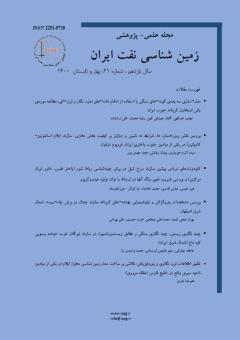مدلسازی سه بعدی گونه های سنگی با استفاده از ادغام داده های مغزه، نگارهای چاه و لرزه ای در یکی ازمخازن کربناته جنوب غربی ایران
محورهای موضوعی : زمین شناسی مخازن نفت
مهدی خیرالهی
1
,
گلناز جوزانی کهن
2
,
رضا محبیان
3
*
![]() ,
علی مرادزاده
4
,
علی مرادزاده
4
1 - دانشگاه تهران
2 - دانشگاه تهران
3 - دانشگاه تهران
4 - دانشگاه تهران
کلید واژه: تعیین گونه های سنگی, خواص مخزنی, شاخص منطقه جریان, داده های مغزه,
چکیده مقاله :
تعیین گونه های سنگی، فرآیند اختصاص خواص مخزن به رخساره های زمینشناسی است و یک گونه سنگی تعیین شده دارای خواص زمین شناسی و مخزنی مشابه و حدوداً یکسان است. امروزه روش های بسیار مختلفی برای تعیین گونه های سنگی پیشنهاد شده و توسعه یافته است. از آن جمله می توان به روش رخساره حفرات و روش لوسیا اشاره کرد که از ویژگی های سنگ شناسی در کنار تخلخل و تراوایی استفاده می کند. از مهمترین این روش ها، تعیین گونه های سنگی به روش شاخص منطقه جریان می باشد. همچنین، معادلات مختلفی مانند وینلند-پیتمن و تابع جی-لورت در این زمینه وجود دارد که از روش های بسیار معتبر در تعیین گونه های سنگی می باشد. در این مطالعه با طراحی یک مسیر کار جدید و با استفاده از مهم ترین و کاراترین روش های تعیین گونه های سنگی اعم از روش های شاخص منطقه جریان، تفکیک تخلخل، شاخص وینلند-پیتمن، شاخص تغییر یافته منطقه جریان و لگاریتم های شاخص منطقه جریان و شاخص تغییر یافته منطقه جریان و اعمال روش های مذکور بر روی داده های مغزه، نگار چاه و لرزه ای، به تعیین گونه های سنگی در سه بعد و در کل میدان مورد بررسی پرداخته ایم. پس از اعتبار سنجی نهایی، به ترتیب، مقادیر ضرایب همبستگی بیش از 83%، 57%، 70%، 70%، 73% و 78% برای روش های مورد استفاده به دست آمد که بیانگر دقت و کارایی بیشتر روش شاخص منطقه جریان جهت تفکیک گونه های سنگی در این میدان می باشد. همچنین مقایسه جزئی نتایج اعتبارسنجی انجام شده پس از به کار گیری هر روش نیز تاییدکننده بیشترین دقت برای روش مبتنی بر شاخص منطقه جریان است. در نتیجه، با ادغام این روش با نشانگرهای لرزه ای، گونه های سنگی را در کل میدان و در سه بعد تفکیک کرده که چهار گونه سنگی مجزا تعیین گردید.
Rock typing is the process of assigning reservoir properties to geological facies, and an identified rock type has similar geological and reservoir properties. Due to the importance of identifying and separating rock types in hydrocarbon reservoirs, various methods have been proposed and developed today for the determination of rock types. One of the simplest methods is the porosity chart against permeability and cut-off determination, and one of the most important and practical of these methods is to determine rock types by flow zone indicator. In this study, we examine one of the most important hydrocarbon fields in the south of Iran where core, well and seismic data are available for the field studied so that by designing a new workflow and with use of the most important and efficient methods of rock typing, including FZI, porosity, Winland-Pitman index, FZI*, and logarithms of FZI and FZI* we have identified rock types in three dimensions and through the whole field. After the final validation, the correlation coefficient values were more than 83%, 57%, 70%, 70%, 73% and 78% for the methods used, indicating greater accuracy and efficiency of the FZI method for the rock types separation in this field. The partial comparison of the validation results after each method employment also confirms the highest accuracy belongs to the FZI method. As a result, by integrating this method with seismic attributes, the rock types have been separated in four different groups throughout the field in three dimensions.

